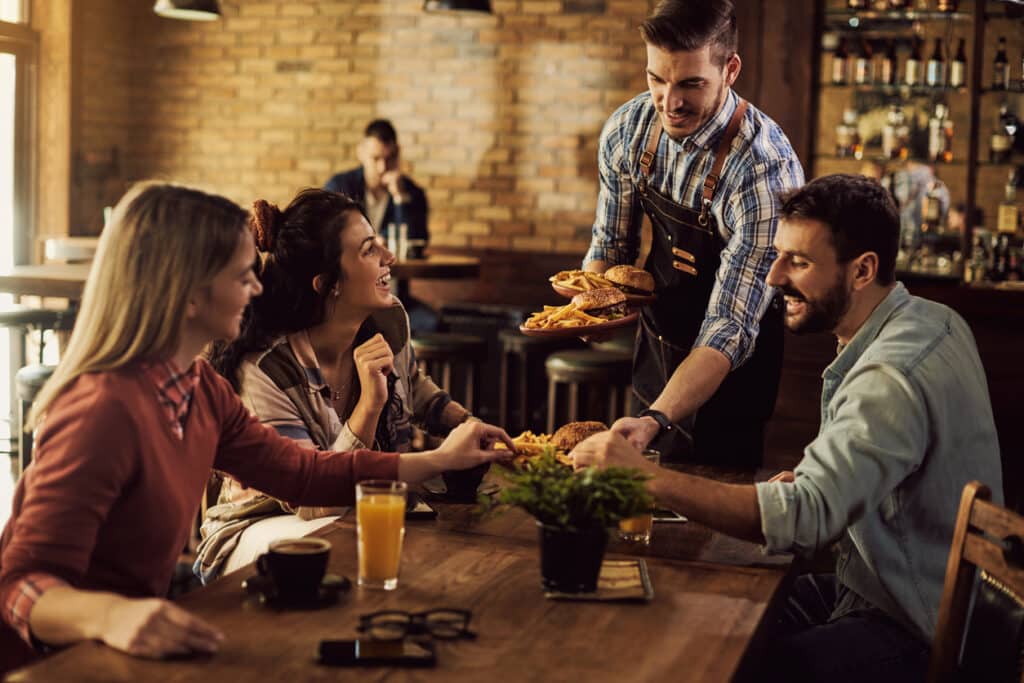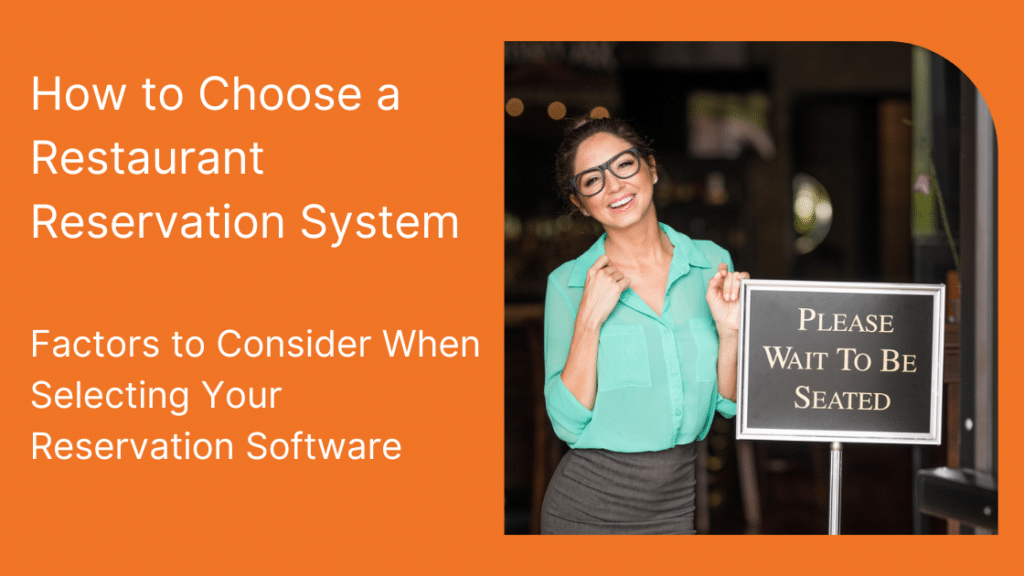For any full-service or specialty restaurant business, front-of-house table management has to be one of the most important things to get right. Even before any customers walk through the door, ensuring a smooth, efficient, and easy process is of paramount importance to the overall customer experience. And that’s not even mentioning the benefits a quality restaurant reservation system provides to your front-of-house staff, allowing them to communicate and collaborate, find solutions in real-time, and generally have an ease and organization to their work.
You can be sure that if there is anything that isn’t right about your restaurant reservation system, you’ll hear about it. Choosing the right reservation system for your food business is one of the most important decisions you can make to ensure that your restaurants are operating at peak efficiency, and profitability.
So, how do you choose the right restaurant reservation software for you? In this article, we’ll go over the main factors to consider and research when making your selection.
Is the Restaurant Reservation System Easy to Use?
The ease of use of a restaurant reservation system is crucial for both your staff and customers. Even if your reservation system has all the bells and whistles, it won’t do you any good if it’s too complicated to actually use it when it’s needed. Consider the following aspects when evaluating the system’s usability:
Intuitive Interface
The reservation system should have a user-friendly interface that is easy to navigate. It should have clear and straightforward instructions, making it simple for staff to manage reservations and for customers to make bookings.
Accessibility
Ensure that the reservation system is accessible from various devices and operating systems. It should be optimized for desktops, tablets, and mobile devices to accommodate both staff and customers who may be using different platforms.
Training and Support
Evaluate the level of training and support provided by the reservation system provider. Look for systems that offer comprehensive training materials, video tutorials, and responsive customer support to assist you and your staff in quickly adopting and utilizing the system effectively.

What are the Integration Capabilities?
A restaurant reservation software that works is guaranteed to be a huge asset. But when it works seamlessly with the rest of your restaurant technology stack, it can be downright invaluable.
Integration with other restaurant management systems is crucial for seamless operations. Consider the following integration capabilities when selecting a restaurant reservation system:
POS Integration
Check whether the reservation system can integrate with your existing POS (Point of Sale) system. This integration allows for streamlined operations, as reservation details can be directly communicated to the POS, ensuring accurate seating arrangements and syncing table availability in real-time.
CRM Integration
Integration with a Customer Relationship Management (CRM) system enables you to capture and store guest information, such as contact details, preferences, and dining history. This information can be used to provide personalized experiences and targeted marketing campaigns.
Website Integration
If you have an existing website, ensure that the reservation system can integrate seamlessly with it. This allows customers to make reservations directly from your website, enhancing the user experience and maintaining your brand consistency.
Third-Party Integrations
Consider whether the reservation system can integrate with other third-party services that are important to your restaurant, such as review platforms, loyalty programs, or online delivery services. These integrations can streamline operations and enhance the overall guest experience.
What Customization Options are Available?
No two restaurants are exactly the same, even when considering multiple locations of the same food business. The ability to customize the reservation system to fit your restaurant’s unique needs and branding is absolutely essential. Here are some customization options to look for when choosing your restaurant reservation software:
Branding and Design
Look for reservation systems that allow you to customize the interface to match your restaurant’s branding, including the use of logos, colors, and fonts. This ensures a cohesive and consistent brand experience for customers.
Floor Plan Customization
A flexible reservation system should allow you to create and customize your restaurant’s floor plan. This feature enables you to define different table configurations, sections, and seating capacities, ensuring accurate table assignments and efficient seating arrangements.
Special Requests and Preferences
Evaluate whether the reservation system can accommodate special guest requests and preferences, such as dietary restrictions, celebrations, or seating preferences. Customizable options allow you to capture and manage these details effectively.
Automated Communications
Look for systems that offer customizable email confirmations, reminders, and follow-ups. This allows you to personalize communication with your guests, reinforcing your brand identity and providing a high level of customer service.

Does the Reservation System Include Table Management Tools?
Efficient table management is essential for optimizing seating capacity, minimizing wait times, and providing a smooth dining experience. Consider the following aspects related to table management tools when evaluating a restaurant reservation system:
Real-Time Table Availability
The reservation system should provide real-time updates on table availability, allowing you to accurately manage reservations and walk-ins. This feature helps optimize seating arrangements and reduces the chances of overbooking or underutilizing available tables.
Table Status Tracking
Look for a system that allows you to track the status of each table, such as whether it is occupied, reserved, or being cleaned. This information helps your staff efficiently manage table turnovers and ensure a smooth flow of operations.
Table Assignment and Rotation
The reservation system should offer features for assigning tables to guests based on their preferences, party size, or special requirements. Additionally, the ability to rotate tables can help distribute seating evenly and maximize the utilization of the dining area.
Waitlist Management
A robust reservation system will include waitlist management tools that allow you to handle walk-in customers effectively. The system should enable you to add customers to the waitlist, estimate wait times, and send notifications when a table becomes available.
Are There Mobile-Friendly Solutions?
With the increasing use of mobile devices, having a mobile-friendly reservation system is crucial for convenience and accessibility. Here’s what to look for when considering the mobile aspects of your restaurant reservation software.
Mobile Reservation App
A reservation system with a mobile app allows customers to make bookings directly from their smartphones. This feature enhances convenience and flexibility for guests, as they can easily reserve a table on the go.
Staff Accessibility
Look for a reservation system that offers a mobile app or web-based interface for your staff. This enables them to manage reservations, check table statuses, and communicate with guests from their mobile devices, providing flexibility and real-time updates.
SMS Notifications
Consider a reservation system that supports SMS notifications to send automated reminders or updates to customers. This feature is especially useful for confirming reservations, notifying guests about table availability, or providing updates on waitlist status.
Mobile-Friendly Interfaces
The reservation system should have a responsive design that adapts to different screen sizes and mobile devices. This ensures that both customers and staff can access and use the system seamlessly, regardless of the device they are using.
Does the System Allow Online Reservations?
In today’s digital era, online reservations have become increasingly popular among diners, and is a near-necessity for full-service and specialty restaurants. Here’s what to look for in terms of online reservation capabilities.
Online Booking Channels
Evaluate whether the reservation system supports multiple online booking channels, such as your restaurant’s website, mobile apps, social media platforms, and third-party reservation platforms. Having a wide range of online booking options increases your visibility and accessibility to potential guests.
User-Friendly Interface
The online reservation process should be intuitive and user-friendly for customers. Ensure that the system provides a seamless online booking experience with clear instructions, easy navigation, and a responsive design that is compatible with various devices.
Real-Time Availability
The reservation system should update table availability in real-time across all online booking channels. This prevents overbooking and ensures that customers receive accurate information about table availability and reservation options.
Reservation Management
Look for features that allow you to manage online reservations efficiently. This includes the ability to view, modify, and cancel reservations, as well as set restrictions on party size, seating times, and special requests.
Does the System Work with Your Budget?
The cost of a quality reservation system is an obvious consideration when making your selection. The hope is that you’ll be able to pay for only what you need, and most systems will claim that that’s possible. But, there are things you should look out for to ensure that you don’t end up paying more than you bargained for. Ask about the following cost-related factors:
Pricing Structure
Different reservation systems have varying pricing structures, including monthly subscriptions, per-reservation fees, or a combination of both. Carefully evaluate the pricing model and determine which option aligns with your budget and projected reservation volume.
Additional Costs
In addition to the base cost, consider any additional fees associated with the reservation system. These may include setup fees, training costs, integration fees with other software systems, or fees for additional features or support.
Scalability
If you have plans for expansion or anticipate significant growth in the future, consider whether the reservation system can scale with your business. Some systems may offer tiered pricing plans or options to add more features or additional locations as your needs evolve.
Return on Investment (ROI)
While it’s important to consider the upfront costs, also evaluate the potential return on investment. A reliable reservation system that improves operational efficiency, enhances the customer experience, and drives more reservations can ultimately generate higher revenue and offset the initial investment.
If you consider all of these factors when exploring your options for restaurant reservation systems, then you can be confident that you’ll be well on your way to choosing the right system for your food business. While your restaurant might have some additional, unique needs in your reservation system, getting answers to these questions will provide you with enough information and research to make a solid choice that will provide the most benefit to you.
For examples of the most popular reservation systems currently available, feel free to check out our article: What is a Restaurant Reservation System? Benefits and Examples
Restaurant Reservation Systems Work Best when Paired with a Quality Restaurant Management Software
There are plenty of features built into modern restaurant reservation systems, but even the best reservation system isn’t enough to keep your restaurants humming at peak efficiency. A quality reservation system is a key component, but it’s still just one piece of the puzzle. You can get the most out of your restaurant reservation system when you pair it with a world-class restaurant management software.
A restaurant reservation system and restaurant management software can work together to create a comprehensive solution for efficiently running and managing a restaurant. By pairing your reservation system with a proven and efficient restaurant management software like SynergySuite, you’ll place your restaurant business in a prime position to maximize your profits and reach new heights.
To learn more about how SynergySuite can help you increase the efficiency and enhance the profitability of your restaurant business, request a demo today.
Learn More About Restaurant Reservation Systems and Restaurant Technology
- Restaurant Reservation Systems
- Restaurant POS Systems and Payment Processing





